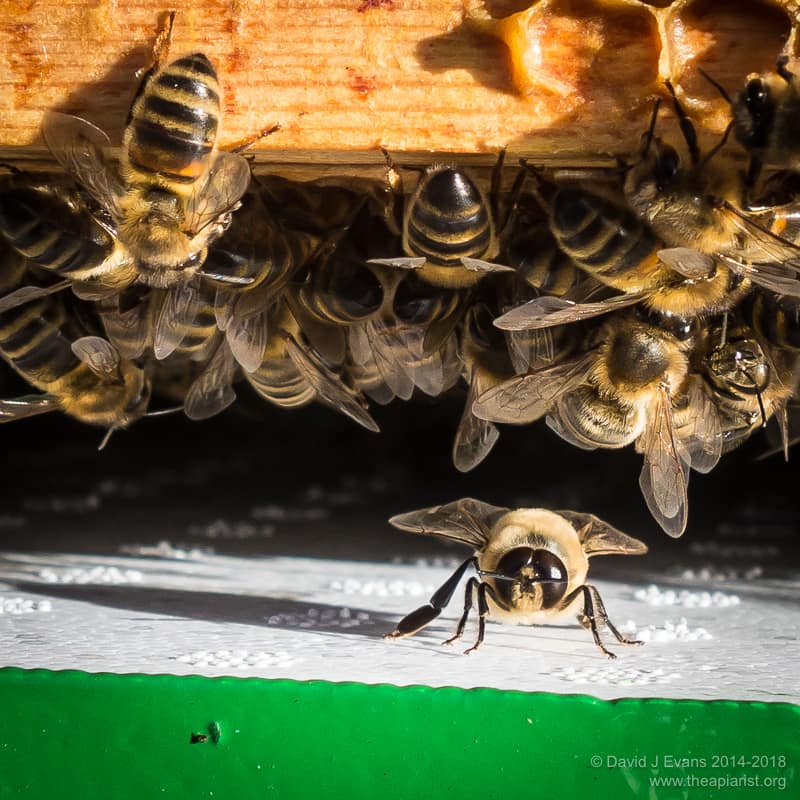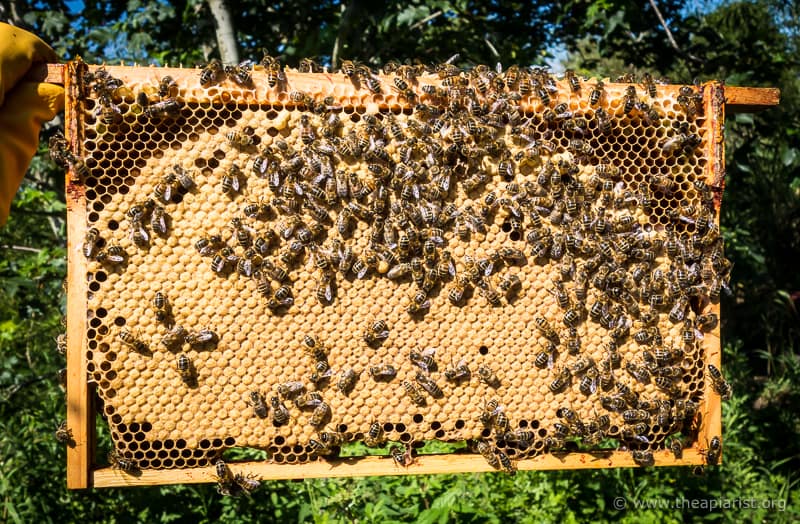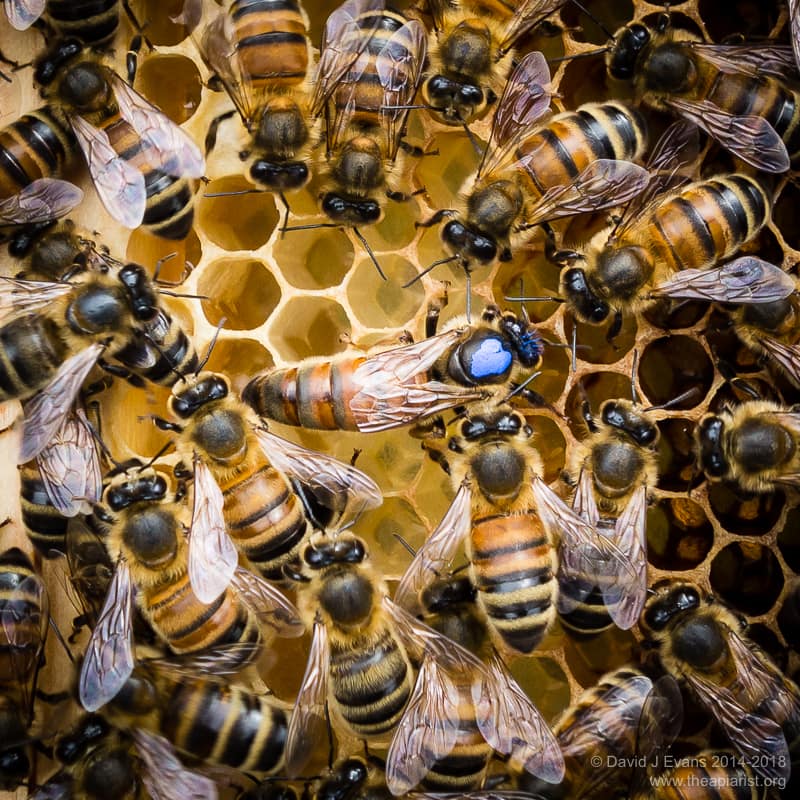Polyandry and colony fitness
Honey bees are polyandrous. The queen mates with multiple drones during her mating flight(s). Consequently, her daughters are of mixed paternity.
In naturally mated queens there is a relationship between the number of patrilines (genetically distinct offspring fathered by different drones) and the ‘fitness’ of a colony.
Colony fitness
A ‘fit’ colony is one that demonstrates one or more desirable traits (those that benefit the colony … and potentially the beekeeper) such as better population growth, weight gain, resistance to pathogens or survival.
If you analyse the molecular genotype of the worker offspring you can determine which patriline they belong to. If you genotype enough workers you start to see the same patrilines appearing again and again. The more patrilines, the more drones the queen mated with {{1}}.
Naturally mated queens mate with ~13 drones. Depending upon the study a range from as low as 1 to as high as 40 (and exceptionally into the high 50’s) has been demonstrated, though different studies all tend to produce an average in the low- to mid-teens.
There is a well-established link between polyandry and colony fitness {{2}}. Essentially, the more genetically diverse a colony i.e. the larger the number of patrilines, the fitter that colony is.
The benefits of polyandry
Why should colonies with increased genetic diversity be fitter?
There are a number of hypotheses that attempt to explain why intracolonial genetic diversity is beneficial. These include the increased behavioural repertoire of the worker bees, a reduced production of diploid drones (which would otherwise be produced due to the single-locus sex determination system) and an increased resistance to a wide range of parasites and pathogens {{3}}.
Parasites and pathogens are an extremely effective evolutionary selective pressure. Several studies from David Tarpy and Thomas Seeley have shown that increased polyandry results in better resistance to chalkbrood and American foulbrood.
But what about Varroa? It’s a new pathogen (evolutionarily speaking) to honey bees and there is evidence that the resistance mechanisms observed are genetically determined {{4}}.
Does polyandry contribute to Varroa resistance?
Would increased polyandry result in improved resistance to mites?
Limits of polyandry and natural resistance
Why is the average number of drone matings in the low teens?
If polyandry is beneficial – and there’s no doubt it is – then surely more patrilines (hyperpolyandry) would be even more beneficial?
How could this be tested?
Naturally mated queens only very rarely exhibit 30+ drone matings. Not only are these colonies hard to find, but they are so rare that doing any sort of statistical analysis of the improved (or otherwise) fitness is probably a non-starter.
Perhaps there’s an alternative way to approach the question? Rather than look at individual colonies within a mixed population, why not study the overall level of polyandry within a population that demonstrates resistance?
For example, do queens that head colonies of untreated feral bees that exhibit a demonstrated enhanced resistance to Varroa, the most important pathogen of honey bees, exhibit higher levels of polyandry?
Two relatively recent scientific papers have tackled these questions. Both have produced clear answers.
Drones : if more is better, is lots more better still?
Yes.
Keith Delaplane and colleagues used instrumental insemination (II) of virgin queens to produce queens ‘mated’ with 15, 30 or 60 drones. Sperm was collected from 1, 2 or 4 drones from 15 donor colonies, mixed thoroughly and used for queen insemination.
Full-sized colonies were requeened with the II queens and left for 6 weeks {{5}} after which sampling started. Over two seasons a total of 37 colonies (with 11, 13 and 13 colonies respectively headed by queens ‘mated’ with 15, 30 and 60 drones) were tested at approximately monthly intervals.
Testing involved visual analysis of colony strength {{6}} and comb construction. Mite levels were measured using standard alcohol wash of ~300 bees at mid- or late-summer timepoints.
The results of this study are commendably brief … just 8 lines of text and two tables. I’ll summarise them in just a couple of sentences.
Colonies headed by queens ‘mated’ with 30 or 60 drones produced significantly more brood than the colony headed by the queen ‘mated’ with only 15 drones. Conversely, significantly more colonies headed by queens mated with only 15 drones had a higher level of mite infestation {{7}}.
Natural Varroa resistance and polyandry
One of the best studied populations of feral bees co-existing with Varroa are those in the Arnot Forest in New York State. These are the bees Thomas Seeley and colleagues study.
These colonies live in natural holes in trees at low density through the forest. The colonies are small and they swarm frequently. Their spatial distribution, size and swarminess (is that a word?) are all evolutionary traits that enable resistance, or at least tolerance, to Varroa and the pathogenic viruses the mite transmits.
I’ve discussed Seeley’s studies of the importance of colony size and swarming previously. I don’t think I’ve discussed his work on spatial separation of colonies, but I have described related studies by Delaplane and colleagues.
Essentially, by being well-separated, mite transmission between colonies (e.g. during robbing) is minimised. Similarly, by existing as small colonies that swarm frequently Iwith concomitant brood breaks) the mite population is maintained at a manageable level.
Do the Arnot Forest Varroa-resistant {{8}} bees exhibit especially high levels of polyandry, suggesting that this contributes their survival?
No.
Seeley and colleagues determined the number of patrilines in 10 Arnot Forest colonies using the same type of genotyping analysis described earlier. They compared these results to a similar analysis of 20 managed honey bee colonies located nearby.
On average, Arnot Forest queens had mated with ~18 drones (17.8 ± 9.8) each. In contrast, queens in managed colonies in two nearby apiaries had mated with ~16 and ~21 drones. These figures are not statistically different from each other or from the natural mating frequencies reported for honey bees in other studies.
Hyperpolyandry and colony fitness
The first of the studies confirms and extends earlier work demonstrating the polyandry (and in this instance hyperpolyandry i.e. at an even greater level than seen normally) increases colony fitness – at least in terms of colony strength and Varroa resistance.
Delaplane and colleagues hypothesise that the increased mite resistance in hyperpolyandrous (30 or 60 drones) colonies may be explained by either:
- the importance of extremely rare alleles (gene variants), which would only be present in colonies in which the queen had mated with a very large number of drones.
- the presence of beneficial non-additive interactions between genetically-determined traits e.g. grooming and hygienic behaviour and reduced mite reproduction.
Neither of which are mutually exclusive and both fit at least some of the extant data on natural mite resistance. Discriminating between these two hypotheses and teasing apart the variables will not be straightforward.
Absence of hyperpolyandry in naturally mite-resistant colonies
At first glance, the absence of the hyperpolyandry in the mite-resistant Arnot Forest bees studied by Thomas Seeley and colleagues appears to contradict the studies using the instrumentally inseminated queens.
The Arnot Forest bees exhibit the same level of polyandry as nearby managed colonies, and for that matter, as colonies studied elsewhere. They are mite-resistant but the queen has not mated with an increased number of drones.
In other studies {{9}}, naturally mated colonies exhibiting different levels of polyandry (within the normal range) showed no correlation between Varroa levels and queen mating frequency.
Perhaps it’s surprising that the Arnot Forest queens hadn’t mated with fewer drones considering the extreme separation of the colonies (when compared with managed colonies). The colony density within the Forest is approximately one per square kilometre.
However, at least during the peak swarming and mating period in the season, drone availability is rarely limiting.
This is because drones are not evenly spread in the environment. Instead, they accumulate in drone congregation areas (DCA) to which the queen flies for mating.
What limits polyandry?
Polyandry is beneficial and, apparently, hyperpolyandry is more beneficial. However, queens mate with 10 – 20 drones, rather than 50 or more. Why is this?
Queen mating is a risky business. The queen has to fly to the DCA, mate with multiple drones and then return to the hive. She may make one or several mating flights.
I’ve discussed how far drones and queens fly to reach the DCA previously. Most drones fly less than 3 miles and 90% of matings occur within about 5 miles of the virgin queen’s hive. The queen probably flies further to the DCA.
All the time she is travelling to and from the DCA, and all the time she is present within it mating, she’s potentially at risk from hungry house martins, swallows, bee eaters (!) or from thunderstorms.
Or simply from getting lost.
Additionally, a number of honey bee pathogens are transmitted between drones and queens during mating. Hyperpolyandrous queens {{10}} are therefore at risk from these sexually transmitted diseases {{11}}.
It’s therefore likely that the level of polyandry observed in honey bees has evolved as a consequence of the beneficial pressures polyandry brings balanced by the risks associated with mating multiple times.
Practical beekeeping
Although the two studies described here don’t have an immediate relevance to day-to-day practical beekeeping, it’s worth remembering that poor queen mating is regularly blamed for queen failures e.g. queens that develop into drone layers during the winter.
I’m going to write about drones later this year so for the moment will just make these points:
- drone production is maximised to generate sexually mature drones for the swarming season
- after eclosion, drones need to mature before being able to mate
- drones live about 30 days and their sperm volume, though not necessarily viability, decreases as they age
Together this means that late in the season – perhaps late July or early August (though this will vary depending upon location) – the number of drones will decrease.
More significantly, the drones will be ageing.
In turn this means that late-mated queens may not mate with as many drones, or that the matings may not result in insemination.
Most beekeepers will be aware of queens that apparently ‘run out of sperm’ and become drone layers.
However, there may be less obvious problems with late-mated queens. I’m not aware of any studies on seasonality of queen mating and polyandry. However, I would not be at all surprised if they exhibited a reduced level of polyandry.
And, as described above, these colonies are likely to exhibit reduced fitness.
Something else to consider when deciding whether to unite a colony late in the season or hope the last of your virgin queens mates successfully …
{{1}}: With the caveat that some of the workers in the colony were not reared in that colony at all.
{{2}}: For example, see Mattila & Seeley (2007) Genetic Diversity in Honey Bee Colonies Enhances Productivity and Fitness. Science 317:362-364.
{{3}}: Again, see Mattila & Seeley (2007) Genetic Diversity in Honey Bee Colonies Enhances Productivity and Fitness. Science 317:362-364.
{{4}}: See Rosenkranz et al., (2010) Biology and control of Varroa destructor. Journal of Invertebrate Pathology 103: S96–S119.
{{5}}: For workers originating from the previous queen to die.
{{6}}: There are well-established methods to do this based upon frame coverage with workers and brood.
{{7}}: The analysis of mite levels was complicated as the overall infestation rate being rather low i.e. many samples contained no mites. Essentially, they ‘flattened’ the data and scored colonies as simply positive or negative for mites and then conducted a chi-squared permutation test to allow comparison of observed vs expected.
{{8}}: Or perhaps tolerant? There is a distinction between these two terms – at least in my mind – and I’m not sure it’s been formally tested. For the purpose of this post I’ll stick with resistant.
{{9}}: See Neumann & Moritz (2000) Testing genetic variance hypothesis for the evolution of polyandry in the honeybee (Apis mellifera). Insectes Sociaux 47:271-279.
{{10}}: Or the long-term viability of the colony she returns to head.
{{11}}: See Yu et al., (2006) Detection of viral sequences in semen of honeybees (Apis mellifera): Evidence for vertical transmission of viruses through drones. Journal of Invertebrate Pathology 92: 105-108.



Join the discussion ...